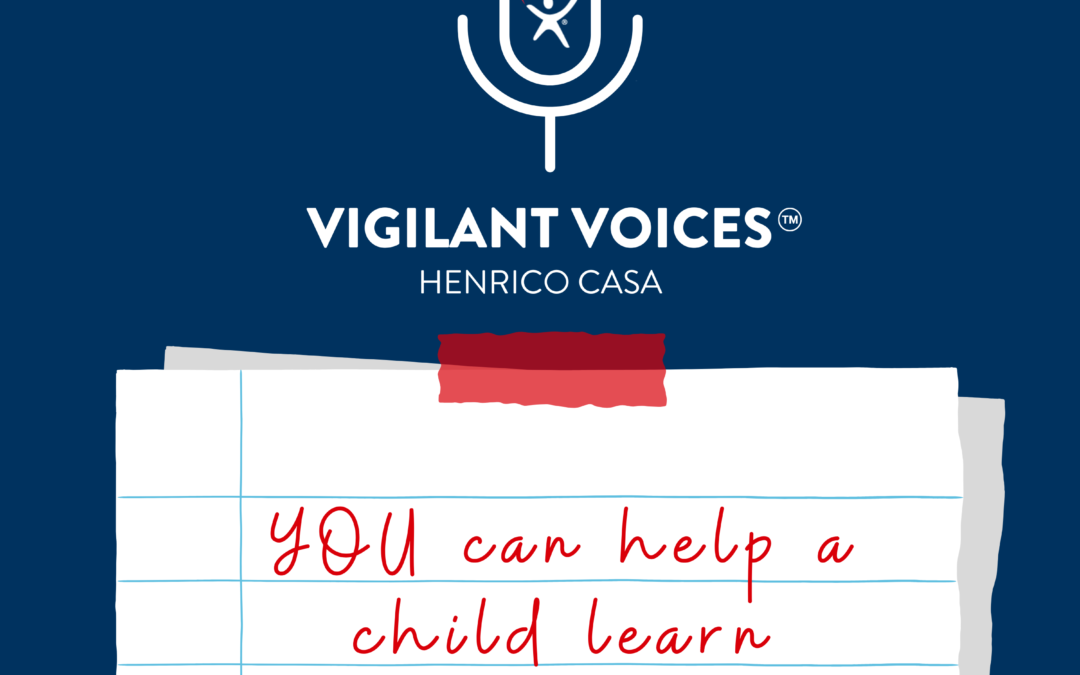
Listen to Episode 13 of the Vigilant Voices™ podcast, YOU Can Help a Child Learn.
Jeannine Panzera: Hello, listeners. We’re happy to have you with us for yet another episode of Henrico CASA’s Vigilant Voices™ podcast. This episode coincides with the start of a new school year…
Kristin Blalock: Which means we made it through the summer, back to schedules, back to structure. Some people may be groaning, but I kind of like the school year.
J: I mean, I do hate saying goodbye to summer, but I also like the fall and getting back to routine. Whether you love or hate it, we can debate that maybe at another time. It’s still great to know about the challenges facing children and families in order to ensure that no child continues to face abuse, neglect, or trauma.
K: Yes, and there are definitely challenges specific to school that vulnerable children face.
J: There are. And so the question that we want to talk through and learn about today is what needs must be met for a child before we can even really expect them to effectively engage in learning?
K: Yes, because children definitely have needs that must be met before their little brains are able to engage in learning.
J: Exactly. I mean, to start, they physically have to be able to even get to school because otherwise they just won’t have a chance at all.
K: Right. Which was the issue in the CASA case story I wanted to share today. This is Raul’s story. He’s a young boy who was appointed a CASA advocate during a really stormy custody dispute. And so in visiting with Raul, his CASA quickly realized that although he was school age, he was not actually going to school. The instability of his family of origin had prevented them from even enrolling him.
J: It’s a sad situation that really does create just a drastic visual, because on the one hand, what you really want to see are all of those cute first day of kindergarten pictures or first day of fifth grade that circulate on social media every August or September back to school time. But in comparison to this case that you just shared, I mean, not only were there no pictures, but, I mean, this child wasn’t even enrolled in school, which is so sad. And so if I’ve learned anything in all years here with CASA, it’s that there are always hidden challenges and issues behind what we just sort of initially see, know what the problem may be.
K: Very true. There are these foundational needs that maybe aren’t being met.
J: And we would say think back to Maslow’s Hierarchy of Needs where we kind of learn about them.
K: So, listener, if you aren’t familiar with this, there’s a visual of a pyramid that’s really helpful to see. So check it out in our show notes. But if you imagine a pyramid shape, there’s a large base, and then layers are kind of built up from there until you reach the top, which is like a point of a triangle. And the idea is that at the top of the pyramid, it represents like a state of thriving. Like, life is great and you’re really living to your full potential, but you can’t just jump up to that point at the very top of the pyramid, each layer of baseline needs must be met kind of one at a time from the bottom up before you can be living life to your potential.
J: Right. And that makes sense. And it also addresses cognitive function. So things like learning, comprehending, remembering, curiosity, all of those are in the middle of the pyramid. Because they actually are a very important part of development. So if you apply that to learning at school, every child has like three or four categories of needs that must first be met at that bottom before we can even expect them to engage in this.
K: And Jeannine, you asked the question a few minutes ago of what needs must be met for a child before we can expect them to be able to learn. And I think the pyramid gives us the answer, right? So let’s talk through the basic needs that are in that foundational level of the pyramid to see how we can best support children, especially children who have experienced trauma.
J: Yeah, that sounds good. So there’s the base of the pyramid, which is what we would call basic needs. So basic needs that we all have as humans, they’re physiological, right? So we need food, we need water, we need clothes, and we need shelter.
K: And luckily, when you think about these types of needs, there are many resources in our community to help with these needs. For instance, that’s the heart of the programs at school that offer free breakfast and reduce lunches. Kids can’t learn when they’re hungry. Having food is a foundational need.
J: Exactly. And so I’m always really happy to see when schools have even adjusted some rules to allow water bottles or even some snacks throughout the day, because that’s a way to ensure that hunger and thirst aren’t a hindrance to their ability to learn, because that’s then the only thing they’re thinking.
K: Right. They can’t think of anything else. And besides food, if you think about the basic need of shelter, that clearly affects having material needs met, getting enough sleep, it just bleeds into so many areas of a child’s life. And I was looking back at our cases from last year, and it looks like about 30% of the families we worked with had housing insecurity as a major concern. And then when you think about housing insecurity, there’s so many other issues kind of on the periphery that arise. Like, if housing is an issue, how do you have transportation to school? How do you have a place to get and keep school supplies? Where do you go to work on your homework? Sometimes there might even be an inability to have an address and that prevents you from enrolling in school.
J: Exactly. And it is compounding then because if we have lots of moves, then lots of schools, then maybe missing school during enrollment or lack of enrollment ability, it can cause a problem. But luckily, there is what we call the McKinney Vento Homeless Assistance Act. And it really is fully focused on helping with this because every child has a right to attend school and receive an education.
K: Yeah, and not only to just attend school, but they have a right to enroll even if they don’t have a steady address. They have a right to have transportation to school. They have a right to participate in extracurricular activities.
J: Exactly. And so the good news is that all schools have contacts who are coordinators for students, families, and other services specifically related to this McKinney Vento Act.
K: Oh, I’m so thankful for that. Okay, so assuming all of these needs are being met, these foundational needs, the next level in the hierarchy is what we would call safety needs.
J: And this is a real difficult one if we’re just being honest and open and transparent in today’s world. So we would hope that there is no question that a child’s safety needs are met at school and that they feel safe there.
K: Yeah, well, and especially if they don’t feel safe at home. Right.
J: But with things that have been happening, students, many of them, don’t feel safe. And even in a school that we hope could be immune from internal, let’s say, issues and turmoil or funding, there’s a lot of issues there, but now we’re dealing with external threats like school shootings that are just way too commonplace. And the things that we’re doing in school to build up security can then make children feel even more scared if they’re seeing police officers present and metal detectors.
K: So true. Think of it from a child’s perspective. You see these metal detectors that from the adult perspective, are here to keep the children safe. But from the child’s perspective, the very presence of those metal detectors makes them feel scared.
J: Exactly. And then in addition to all of that, we talk a lot about the children and the youth that we work with who have experienced abuse and neglect. So in general, they’re on kind of a high alert for different things. And so we see them operating in a bit of survival mode. We’ve talked about that a little bit, but they’re hyper vigilant to everything that’s happening around them because they’re a little bit more concerned.
K: Right. Which means even perceived threats or nonthreats can elicit a response from them. So something like a teacher getting a message on their walkie talkie, there might not actually be an issue of any kind, but that child may not know that. And they become distracted, anxious, maybe jump to conclusions. Like the worst scenario is happening.
J: Right. Like, what was that message about? Because it took away some of the attention of the teacher for a moment. And so how in the world can we expect these children to focus when their brains are going so fast and they just have so much going on?
K: Right.
J: So before we digress into all of the ways that we would like to see make schools safer and a true safe haven, which is beyond what we can do, there are still ways, though, that we can all look to try to help these children who are just kind of have that hyper vigilance stay more regulated. And so that means staying calm or returning to that state of calm like de-escalating as quickly as possible after an incident occurs.
K: And what’s extra difficult is that we as parents or we as caregivers or advocates, we aren’t with them at school. So when something’s happening, we’re not there to talk through the issues. So we need to give them tools, maybe a mantra to repeat to themselves, maybe little fidgets to focus their energy on, or a notebook for writing down their thoughts, a song to hum… anything like that.
J: Just try to have them do some self regulation.
J: Right, but the other reality, though, is that children with mental health issues or severe trauma may need more, may need some more interventions. And we might see that in the form of what we would call a 504 plan at school. And that oftentimes comes with a lot of accommodations that the teachers and support staff are able to implement to help them stay regulated. And this is where an advocate like our CASA volunteers can be really helpful to advocate for these type of plans or accommodations.
K: For sure. And gosh, we could stay on this topic of regulation for a long time, but let’s keep kind of moving upward through the pyramid. And so when those physical needs are met, when the safety needs are met, the next level that needs to be met are the child’s social and esteem needs.
J: And we talk about these all of the time. So children, as we know, and teenagers are included in this, they need to feel loved and valued and accepted and they really do need to know that they have somewhere that they belong.
K: Yeah, and they need to learn both self respect and have a healthy respect for others. And since we’re specifically talking about school, it’s important to note that they need this in terms of their peers, but also adults. And for these students who have experienced trauma, this is especially true because they need a sense of safety. And that can be the relational safety that comes from having a safe adult in your life.
J: Right. And so they need to know that they are seen, that they are known, that they’re not invisible, and that they can expect a certain safe, but then also appropriate, response from someone. And so that relational safety is about feeling not only physically safe, but emotionally getting the correct response so they can feel safe in that way as well.
K: Right, and I can say I saw this idea of relational safety play out so well in the elementary school my children went to. They each kind of ended up having a go to person. And it was informal. It wasn’t like an accommodation. But they each knew someone at school who made them feel good about themselves, who would be available to them.
J: Right. They each had their one person that they knew they could depend on.
K: Right. And I made sure to let those staff members know that my kids thought of them kind of as their person. And that just helped the relationship blossom, because that staff member knew they were being counted on, in a sense. And it wasn’t anything huge. Like, one teacher kept a coloring book in her drawer, and when my daughter was upset, she could just quietly take out the coloring book and calm herself down. My other daughter was scared of storms, and there was a parent who would just kind of quietly pray for her in the hallway. No one noticed, but it was important to her. And then one of my sons had someone who would just peek her head in his classroom, like, make eye contact. Nothing major, but, like, I see you .I’m checking on you. I’m glad you’re here.
J: Yeah, I love that. And when I think there is that sense of belonging. Okay, we have those physiological, those physical needs being met, and then we have safety. Well, now we have a child who is much more ready to engage cognitively so they can learn.
K: And that’s what we saw with Raul from our CASA story. There were many physiological and safety needs going unmet in his family of origin. And so his CASA advocate saw these things and started connecting him and his family to resources. And in an interesting twist, his advocate actually advocated for the court to keep his case open for longer than originally expected.
J: Yeah. And I think, Kristin, the reason that you used the word ‘twist’ is because usually we’re hoping that because of our involvement, we’re able to really understand the needs and that we can help that child’s case close more quickly, because that means that we’ve helped find stability and we’ve helped bring closure to whatever that situation was. But we also sometimes really know that we need to see a little more progress.
K: And in staying open, it allow the court to order more services for this family and to specifically enforce a court order that Raul will be enrolled in school. So beyond enrollment, his advocate also recommended that he receive intensive in home counseling and a therapeutic mentor, and he did, in fact, get those services.
J: Love that example. Luckily, Raul’s CASA advocate not only helped him get those physical and safety needs met, but then she also provided that relational safety just by being present for him. And so this idea of relational safety is really sticking with me, because that’s exactly the kind of thing that would make a great call to action this week. What do you think?
K: Yep. Because we can all do it.
J: Yes. So choose a child and think about how you can help build them up and feel physically and or emotionally safe, just like through your relationship with them. Could be something as simple as making eye contact. Give them that little wink every time you see them. That high five, that fist pump. Little secret handshake. But have something that you do consistently that over time, will convey safety, security, and a sense of being known.
K: Because we all want to be known.
Click to learn more about how you can help children in need by volunteering locally as a Court Appointed Special Advocate.








